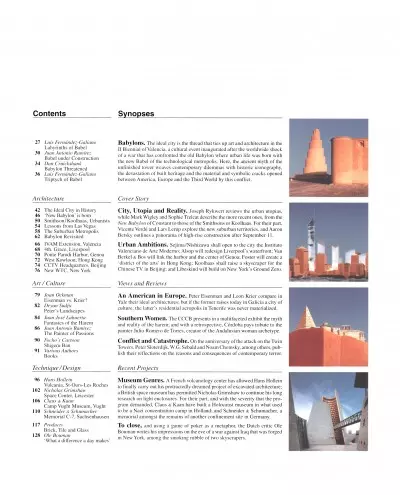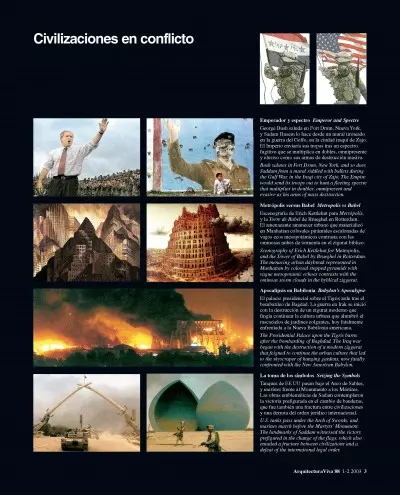Synopses
Babylons. The ideal city is the thread that ties up art and architecture in the II Biennial of Valencia, a cultural event inaugurated after the worldwide shock of a war that has confronted the old Babylon where urban life was born with the new Babel of the technological metropolis. Here, the ancient myth of the unfinished tower weaves contemporary dilemmas with historic iconography, the devastation of built heritage and the material and symbolic cracks opened between America, Europe and the Third World by this conflict.
Contents
Luis Fernández-Galiano
Labyrinths of Babel
Juan Antonio Ramírez
Babel under Construction
Dan Cruickshank
Babylon Threatened
Luis Fernández-Galiano
Triptych of Babel
Cover Story
City, Utopia and Reality. Joseph Rykwert reviews the urban utopias, while Mark Wigley and Sophie Trelcat describe the more recent ones, from the New Babylon of Constant to those of the Smithsons or Koolhaas. For their part, Vicente Verdú and Lars Lerup explore the new suburban territories, and Aaron Betsky outlines a panorama of high-rise construction after September 11.
Architecture
The Ideal City in History
‘New Babylon’ is born
Smithson/Koolhaas, Urbanists
Lessons from Las Vegas
The Suburban Metropolis
Babylon Revisited
Urban Ambitions. Sejima/Nishizawa shall open to the city the Instituto Valenciano de Arte Moderno; Alsop will redesign Liverpool’s waterfront; Van Berkel & Bos will link the harbor and the center of Genoa; Foster will create a ‘district of the arts’ in Hong Kong; Koolhaas shall raise a skyscraper for the Chinese TV in Beijing; and Libeskind will build on New York’s Ground Zero.
IVAM Extension, Valencia
4th. Grace, Liverpool
Ponte Parodi Harbor, Genoa
West Kowloon, Hong Kong
CCTV Headquarters, Beijing
New WTC, New YorkViews and Reviews
An American in Europe. Peter Eisenman and Leon Krier compare in Yale their ideal architectures; but if the former raises today in Galicia a city of culture, the latter’s residential acropolis in Tenerife was never materialized.
Art / Culture
Joan Ockman
Eisenman vs. Krier?
Deyan Sudjic
Peter’s Landscapes
Southern Women. The CCCB presents in a multifaceted exhibit the myth and reality of the harem; and with a retrospective, Córdoba pays tribute to the painter Julio Romero de Torres, creator of the Andalusian woman archetype. Juan José Lahuerta
Fantasies of the Harem
Juan Antonio Ramírez
The Painter of PassionsConflict and Catastrophe. On the anniversary of the attack on the Twin Towers, Peter Sloterdijk, W.G. Sebald and Noam Chomsky, among others, publish their reflections on the reasons and consequences of contemporary terror.
Focho’s Cartoon
Shigeru Ban
Various Authors
Books
Recent Projects
Museum Genres. A French volcanology center has allowed Hans Hollein to finally carry out his protractedly dreamed project of excavated architecture; a British space museum has permitted Nicholas Grimshaw to continue his long research on light enclosures. For their part, and with the severity that the program demanded, Claus & Kaan have built a Holocaust museum in what used to be a Nazi concentration camp in Holland; and Schneider & Schumacher, a memorial amongst the remains of another confinement site in Germany.
Technique / Style
Hans Hollein
Vulcania, St-Ours-Les Roches
Nicholas Grimshaw
Space Center, Leicester
Claus & Kaan
Camp Vught Museum, Vught
Schneider & Schumacher
Memorial C-7, Sachsenhausen
To close, and using a game of poker as a metaphor, the Dutch critic Ole Bouman writes his impressions on the eve of a war against Iraq that was forged in New York, among the smoking rubble of two skyscrapers. Products
Brick, Tile and Glass
Ole Bouman
‘What a difference a day makes’
Luis Fernández-Galiano
Civilizations in Conflict
Emperor and Spectre
George Bush salutes in Fort Drum, New York, and so does Saddam Hussein from a mural riddled with bullets during the Gulf War, in Zajo, Iraq. The Empire would send its troops out to hunt a fleeting spectre that multiplies in doubles, evasive and omnipresent as his arms of mass destruction.
Metropolis vs Babel
Scenography of Erich Kettelhut for Metropolis, and the Tower of Babel by Brueghel in Rotterdam. The menacing urban dawn that materialized in Manhattan colossal stepped pyramids with vague mesopotamic echoes stands in contrast with the ominous storm clouds in the byblical ziggurat.
Babylon’s Apocalypse
The Presidential Palace on the Tigris River on fire after Baghdad’s bombing. The Iraq war began with the destruction of a modern ziggurat which feigned to continue the urban culture that built the skyscraper of hanging gardens, now fatally confronted with the American New Babylon.
Seizing the Symbols
U.S. tanks pass under the Arch of Swords, and marines advance before the Martyrs’ Monument. The landmarks of Saddam witnessed the victory prefigured in the change of the flags, which also produced a deep fracture between civilizations and a defeat of the international legal order.








